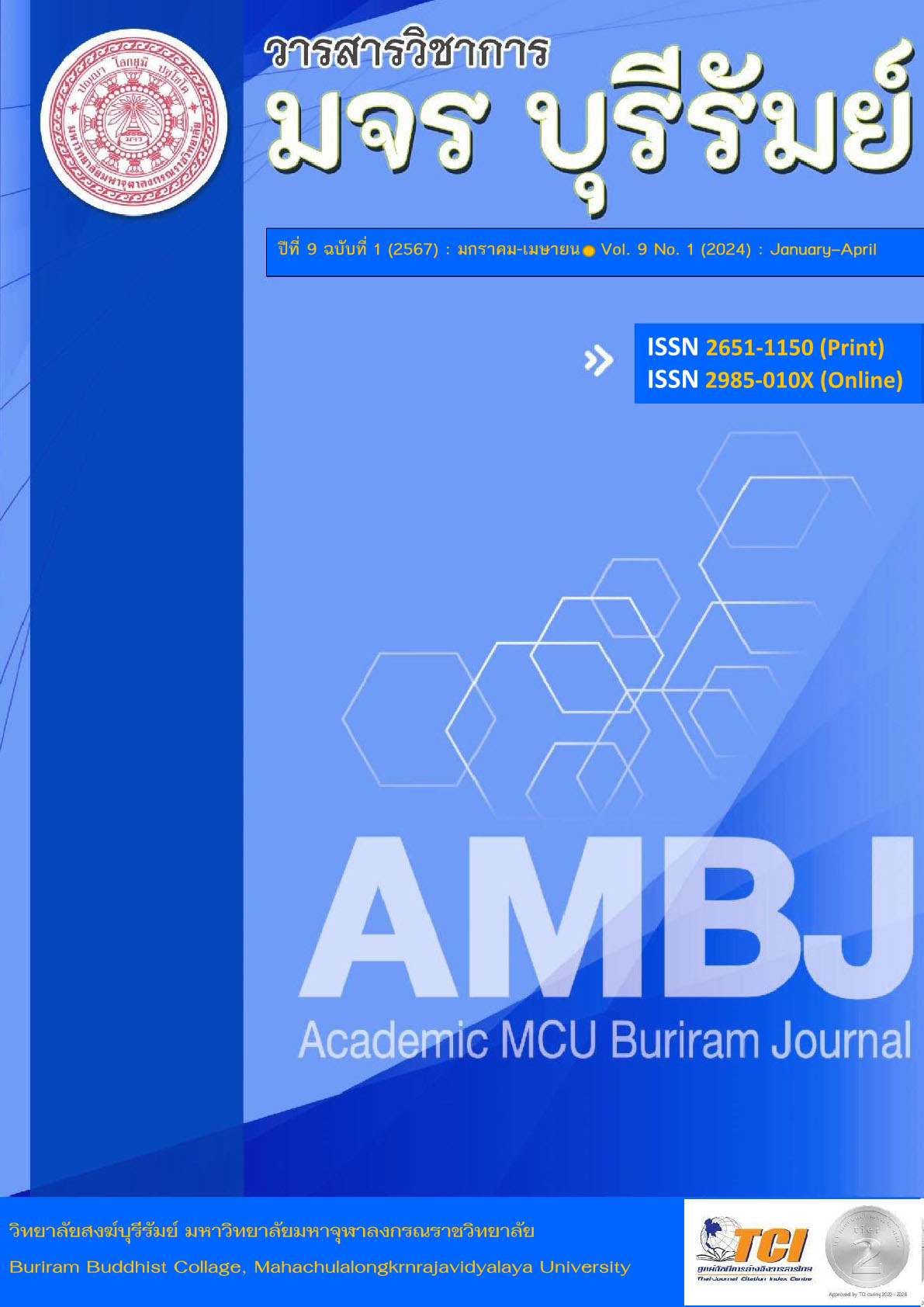Development of Primary Students’ Competency Using Collaboration of Active Learning Management
Keywords:
Competency, Active Learning Management, Co-5 STEPS ProcessAbstract
The purpose of this research were: 1) explore basic information on proactive teaching and learning, competency development for primary school students and teacher development guidelines. 2) create and develop and apply the teacher development program on collaborative active learning to develop teachers and 3) study student competencies after learning with collaborative active learning to develop the competencies of elementary school students. The target group includes 138 primary school teachers, 5 experts, and 34 students, academic year 2023. Tools include teacher development programs, questionnaires, competency assessment forms, satisfaction questionnaires and performance observation form. Statistics were used in the research included frequency, percentage, mean, standard deviation, t-test and content analysis.
The research result found that:
1. Proactive teaching and learning management by teachers is overall at a moderate level. The overall needs for promoting student competency are at the highest level. Overall teacher development guidelines are at a high level and interest in training is mostly at a high level.
2. The program has 7 elements, including the background of the national strategy aimed at developing all-round people, especially student competencies in 5 areas, through the management of proactive learning in a combined 5 As for the principle, it is about developing teachers to promote student competency. The program is flexible in terms of time and focuses on practice with PCL. The objective is to provide teachers with knowledge, understanding according to the specified content. The program structure has 5 units and takes 18 hours. There is content about active learning management, etc. The media used include training documents, etc., and there is an evaluation before and after the training.
3. Using the program, it was found that teachers had higher knowledge and understanding after the training than before the training, with statistical significance at the .05 level. Teachers were overall satisfied at the highest level.
4. Students had competency after learning with 5 steps of active learning management, overall at a high level.
References
กระทรวงศึกษาธิการ. (2551). หลักสูตรแกนกลางการศึกษาขั้นพื้นฐาน พุทธศักราช 2551. กรุงเทพมหานคร: โรงพิมพ์ชุมนุมสหกรณ์การเกษตรแห่งประเทศไทย.
จิตติน แพลงสันเทียะ. (2564). ผลการจัดการเรียนรู้เชิงรุกเพื่อส่งเสริมทักษะการพูดภาษาอังกฤษเพื่อการสื่อสารของนักเรียนระดับชั้นมัธยมศึกษาปีที่ 4. วารสารอิเล็กทรอนิกส์ทางการศึกษา, 9(4), 122-136.
จิราพร มะสุใส. (2565). สภาพความต้องการจำเป็นและแนวทางพัฒนาครูในการจัดการเรียนรู้เชิงรุกของโรงเรียนในสังกัดสำนักงานเขตพื้นที่การศึกษาประถมศึกษานครพนม เขต 2. วารสารรัชต์ภาคย์, 16(47), 238-253.
เฉลิมพล สุปัญญาบุตร. (2562). การพัฒนาโปรแกรมเสริมสร้างสมรรถนะครูด้านการจัดการเรียนรู้เชิงรุกสังกัดสำนักงานเขตพื้นที่การศึกษามัธยมศึกษาเขต 24. วิทยานิพนธ์มหาบัณฑิต สาขาวิชาการบริหารและพัฒนาการศึกษา. บัณฑิตวิทยาลัย: มหาวิทยาลัยมหาสารคาม.
ชูชัย สมิทธิไกร. (2558). การฝึกอบรมบุคลากรในองค์กร. พิมพ์ครั้งที่ 9. กรุงเทพมหานคร: สำนักพิมพ์จุฬาลงกรณ์มหาวิทยาลัย.
ณรงวิทย์ แสนทอง. (2547). มารู้จัก COMPETENCY กันเถอะ. กรุงเทพมหานคร: เอช อาร์ เซ็นเตอร์.
ประกาศิต อานุภาพแสนยากร. (2556). การจัดการเรียนรู้. มหาสารคาม: สำนักพิมพ์มหาวิทยาลัยราชภัฏมหาสารคาม.
ปริญญา มีสุข. (2552). ผลของการออกแบบโปรแกรมการพัฒนาทางวิชาชีพแบบมีส่วนร่วมของครู. วิทยานิพนธ์ดุษฎีบัณฑิต สาขาวิชาการบริหารการศึกษา. บัณฑิตวิทยาลัย: จุฬาลงกรณ์หาวิทยาลัย.
พิมพันธ์ เดชะคุปต์ และพเยาว์ ยินดีสุข. (2563). การเรียนรู้เชิงรุกแบบรวมพลังกับ PLC เพื่อการพัฒนา. กรุงเทพมหานคร: สำนักพิมพ์แห่งจุฬาลงกรณ์มหาวิทยาลัย.
ไพฑูรย์ สินลารัตน์ และคณะ. (2550). สัตตศิลา : หลัก 7 ประการสำหรับการเปลี่ยนผ่านการศึกษาเข้าสู่ยุคเศรษฐกิจฐานความรู้. กรุงเทพมหานคร: สำนักพิมพ์จุฬาลงกรณ์มหาวิทยาลัย.
ภูมิพงศ์ จอมหงส์พิพัฒน์. (2564). การพัฒนาหลักสูตรฝึกอบรมเพื่อเสริมสร้างความสามารถในการจัดการเรียนรู้เชิงรุกของครูประถมศึกษา สังกัดสำนักงานเขตพื้นที่การศึกษาประถมศึกษาอุบลราชธานี. วารสารสังคมศาสตร์และมานุษยวิทยาเชิงพุทธ, 6(7), 334-349.
สมชาย กิจยรรยง. (2552). เทคนิคการจัดอบรมอย่างมีประสิทธิภาพ. กรุงเทพมหานคร: เอชเอ็นกรุ๊ฟ.
สำนักคณะกรรมการการศึกษาขั้นพื้นฐาน. (2552). สมรรถนะหลัก 6 ด้าน. เข้าถึงได้จากhttps://cbethailand.com/A3 (สืบค้นเมื่อ 17 มกราคม 2566).
สุกัญญา รัศมีธรรมโชติ. (2548). แนวทางการพัฒนาศักยภาพมนุษย์ด้วย Competency based learning. พิมพ์ครั้งที่ 2. กรุงเทพมหานคร: ศิริวัฒนาอินเตอร์พริ้นท์.
สุพิษ ชัยมงคล. (2556). กลยุทธ์การพัฒนาสมรรถนะการจัดการเรียนรู้เชิงรุกของครูผู้สอนระดับประถมศึกษาในพื้นที่สูง. วารสารบริหารการศึกษา มศว, 10(18), 61-71.
อาภรณ์ ภู่วิทยพันธุ์. (2551). กลยุทธ์การพัฒนาทรัพยากรมนุษย์. กรุงเทพมหานคร: เอชอาร์เซ็นเตอร์.
Marzec, R. P. (2015). Militarizing the environment : Climate change and the security state. University of Minnesota Press.
Taba, H. (1962). Curriculum development theory and practice. New York: Harcourt, Brace & World, INC.
Downloads
Published
How to Cite
Issue
Section
License
Copyright (c) 2024 Academic MCU Buriram Journal

This work is licensed under a Creative Commons Attribution-NonCommercial-NoDerivatives 4.0 International License.
ทัศนะและความคิดเห็นที่ปรากฏในบทความวารสารฉบับนี้ถือเป็นความรับผิดชอบของผู้เขียนบทความนั้น ไม่ถือเป็นทัศนะและความรับผิดชอบของบรรณาธิการ





